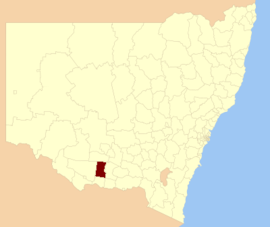| Jerilderie Shire New South Wales | |||||||||||||||
|---|---|---|---|---|---|---|---|---|---|---|---|---|---|---|---|
 Jerilderie Shire Council office and chambers. | |||||||||||||||
 Location of Jerilderie Shire in New South Wales | |||||||||||||||
| Coordinates | 35°21′S 145°44′E / 35.350°S 145.733°E | ||||||||||||||
| Population | 1,526 (2012)[1] | ||||||||||||||
| • Density | 0.45242/km2 (1.1718/sq mi) | ||||||||||||||
| Established | 1918 | ||||||||||||||
| Abolished | 2016 | ||||||||||||||
| Area | 3,373 km2 (1,302.3 sq mi) | ||||||||||||||
| Council seat | Jerilderie[2] | ||||||||||||||
| Region | Murray | ||||||||||||||
| State electorate(s) | Albury | ||||||||||||||
| Federal division(s) | Farrer | ||||||||||||||
| |||||||||||||||
Jerilderie Shire was a local government area in the Murray region of southern New South Wales, Australia. The Shire was located adjacent to the Newell Highway. The Shire was declared in 1918 after the amalgamation of the former Municipality of Jerilderie (1889 – 1918) and Wunnamurra Shire (1906 – 1918). It was dissolved in 2016 after its amalgamation with Murrumbidgee Shire to create Murrumbidgee Council
At the time of dissolution, Jerilderie Shire was the second smallest local government area in New South Wales, in terms of population.[citation needed]
The final mayor of Jerilderie Shire was Cr. Ruth McRae, an unaligned politician. The seat of the council was located in Jerilderie, the only significant town in the Shire.
- ^ "3218.0 - Regional Population Growth, Australia, 2012". Australian Bureau of Statistics. 30 August 2013. Retrieved 27 March 2014. Estimated resident population (ERP) at 30 June 2012.
- ^ "Jerilderie Shire Council". Department of Local Government. Archived from the original on 6 September 2006. Retrieved 1 December 2006.